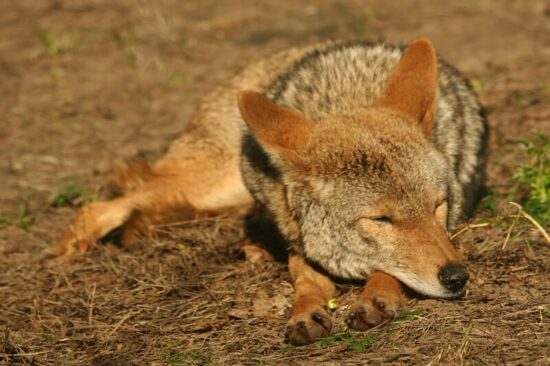Many people are familiar with coyotes, but don’t know much about their behavior. And with an increasing number of these animals living near humans, we think it’s a good idea to understand them a bit more!
This guide will teach you where coyotes sleep, and what their sleeping habits are like in different environments.
Table of Contents
Where Do Coyotes Sleep?
The coyote is a North American canine that can be found just about everywhere on the continent. Because coyotes are fairly secretive, you may not even know that you have them in your area until you hear their distinctive, blood-chilling howl.
Even though coyotes can be found in urban environments, they vastly prefer to live in open, human-free areas such as grasslands, semi-arid locations, and even deserts.
When many people think of coyotes, they usually picture a sneaky animal that raids chicken coops in the middle of the night. While it’s true that many coyotes do hunt at night, many coyotes are just as active during the day.
But where do coyotes sleep?
In this guide, we’ll take a look at where coyotes sleep as well as some of the factors that may determine the kinds of places where they prefer to rest. This will be helpful if you’re looking to keep coyotes away from your property, or simply want to feel safe when going for a hike.
Expert Tip: It’s important to note that the only time that coyotes will create an actual den is when there are pups involved. Mothers will often move their pups from one den to another to maximize safety and to ensure a source of food. Other than that, coyotes will usually sleep in the open or in some kind of temporary shelter.
1. Burrows Made By Other Animals
When looking for a place to sleep or create a den, coyotes will usually make a choice based on the following factors:
- The type of climate
- Available food sources
- The type of landscape
- How many coyotes will be in the shelter
- If there are pups that need extra protection and shelter
A coyote, that is roaming around looking for food or for a mate, will usually search for an easy place to shelter for a day or two. Coyotes will often sleep in a burrow made by another animal as their temporary sleeping spot.
Depending on climate conditions and the nature of the landscape, this burrow could be from a raccoon, badger, skunk, fox or other small animal. Since coyotes are considerably larger than any of these animals, the coyote will usually find it necessary to enlarge the size of the burrow.
For example, in the environment of the prairie you’ll often see coyotes sleeping in the burrows of prairie dogs. These prairie dog homes are usually large enough to be quite comfortable, and since a prairie dog burrow is part of a much larger system of burrows, coyotes can almost always count on an ample food supply. Prairie dogs are a favorite snack for coyotes living out on the prairie.
2. Hollowed-Out Trees
Hollowed-out tree stumps are another common place where coyotes will sleep. A den made from a hollow tree stump or log can make a very safe and cozy spot for a single coyote or a female coyote and her pups.
Which hollow log or stump they choose depends a lot on the terrain and environment. Coyotes like to be able to see their surroundings, so in open areas, they will tend to choose a log that offers unimpeded views in all directions.
However, in a heavily forested area coyotes will tend to sleep in a log that is protected by berry bushes, poison ivy or other plants. This is because if a coyote is not able to have a constant view of its surroundings, it will want to make sure that the shelter has adequate protection. A coyote’s excellent sense of smell and hearing will help to give it protection as well.
3. Dens That They Dig
If a coyote can’t find a ready-made space to sleep during the day, they will often dig their own dens. Although they usually prefer to use a sleeping spot already made by another animal, they are able to easily dig their own spot if the soil is fairly soft.
When looking for a place to start digging, a coyote will search out the place where it feels the safest. Unfortunately, if you have a large or secluded backyard, this safe place could be on your property. Sometimes, a coyote will lose the fear of humans, and it will seek the shelter of a peaceful backyard.
Expert Tip: Never try to deal with a coyote on your own. This can be dangerous, and we highly suggest calling your local animal control specialist. They will be the ones to guide you towards the best and safest solution.
4. Outcroppings
As we’ve discussed, coyotes will always try to seek a shelter where they will feel safe, and where they are best able to see what’s going on in their surroundings. In the case of a desert environment or one that is flat with little shelter, coyotes will look for some kind of outcropping in order to sleep safely. This can be a big pile of rocks or a group of boulders where they can hunker down, keep an eye out for danger, and stay out of sight of predators or humans.
If you live in an area where coyotes are present, and you live near a hilly or rocky landscape, always pay attention around these kinds of outcroppings. A coyote would most likely never harm you on purpose, but one that is cornered or feels afraid may attempt to defend itself or its pups. Again, any coyotes found in or near an outcropping on your land should be treated with the utmost caution.
Where Do Coyotes Sleep In Urban Areas?
Coyotes that live near heavily populated areas face special challenges. By nature, coyotes are shy creatures that try to avoid any contact with humans. Unfortunately, because more and more of a coyote’s habitat is lost to land development, many of these animals are forced to try to co-exist with humans.
There are a few positive points for coyotes living in populated areas. One plus is that there is a consistent supply of small, prey animals like mice, rabbits, pigeons, rats and even roadkill. This goes contrary to the popular belief that urban coyotes survive by raiding garbage cans or by eating family pets. Secondly, in an urban environment, there aren’t really any predators to worry about. Humans are the only real threat, and coyotes try to stay away as much as possible.
Coyotes are fairly large animals, so it would seem that they would have a difficult time finding safe and hidden places to sleep. They are very adaptable animals, however, and coyotes are able to use this adaptability to come up with some ingenious sleeping spots.
Almost every city or suburb has some kind of a park or wooded area. These spots are typically where coyotes sleep when in an urban area.
Another place where coyotes tend to seek a safe sleeping spot is on a golf course. It makes sense because golf courses usually have groupings of trees, bushes and even outcroppings. Unless a golfer has to go into the shrubbery in search of a stray ball, a well-hidden coyote is able to sleep undetected, even in the daytime.
In urban areas where there aren’t many nice, more natural areas, coyotes may have to choose less cushy sleeping arrangements. Drainage pipes, abandoned buildings and houses, bridge underpasses and even alleyways are all places where coyotes are known to sleep.
Do Coyotes Return To The Same Sleeping Spot?
You may be wondering, especially if you have coyotes in your neighborhood or yard, if they return to the same sleeping spot night after night. The answer will depend on if the coyotes have created an actual den, or if they are just grabbing a random place for a couple of sleeps.
As we mentioned earlier, coyotes won’t create an actual long-term den unless they are creating a safe place for raising pups. Sometimes the parents will dig a den from scratch, or they will use a very sheltered outcropping or a well-drained hollow tree stump. Even though the coyote mothers may move the pups from time to time between dens, it is frequently a more long-term situation.
However, if there are no pups involved, then most coyotes prefer to move around in search of a reliable food source and safety from humans. They might sleep in the same hollow log or outcropping once or twice, but they won’t turn it into a permanent home.
Do Coyotes Sleep During The Day Or At Night?
There are many factors that will influence whether coyotes sleep in the nighttime or during the day. Even though they can often be heard howling at night, they are actually diurnal animals. This means that their natural sleeping pattern is to sleep at night and come out during the day. However, since their tendency is to hunt closer to either dawn or dusk, many people think that coyotes are nocturnal.
However, many coyotes have adjusted their sleeping habits to stay awake at night, and we will take a look at some of the reasons for this change in their natural behavior.
One important reason why a coyote would choose to sleep when it’s light out and stay awake at night is if their food source is best accessed during nighttime hours. So if you are being kept awake by coyotes howling at night, it may be because they have changed their sleep pattern in order to take advantage of better hunting opportunities.
Coyotes that live in places where they are more likely to encounter humans, will usually opt for the “hunt at night and sleep during the day” resting pattern. These animals are more afraid of you than you are of them, and they will do just about anything to avoid coming in contact with you. By sleeping in a well-hidden spot during daytime hours, they have a better chance to miss being spotted by humans.
If you live on a farm or ranch, or if you have animals such as chickens, sheep or goats, then coyotes may also choose to sleep during the day and remain awake at night in order to make use of the easy hunting opportunities that these domestic animals offer.
When Are They Most Active?
We already learned that coyotes, depending on certain factors, may choose to be the most active either in the daytime or during the night. Where a coyote will sleep, hunt and raise a family will also depend on the time of year.
During the months of January to March, coyotes are spending their time in pursuit of finding a partner to mate with. This is a time when coyotes, especially males, are very active and may often be seen moving from place to place in search of the perfect mate. They can also be quite vocal during this time of the year, so excessive howling is a sure sign that male coyotes are in your area.
Another time of the year where both males and females are quite active is during spring and summer. This is the time when all the pups that were born and sheltered during the winter months, come out to explore their new world. It is also the time that parents will be very focused on hunting in order to keep up with the appetites in their growing brood.
The months between October and January can be fairly active months as well because the pups that were just venturing out in the springtime, are now getting ready to head out on their own. Then the whole cycle gets ready to start again.
Where Do They Sleep In The Winter?
Coyotes don’t hibernate like other mammals such as bears, skunks, hedgehogs and chipmunks. Instead, they are fully active and need to adapt to an often harsh winter environment. Over time, coyotes have adapted quite well to the challenges of hunting and finding places to sleep during the winter months.
One thing that helps coyotes during the winter is their thick coat. Once the weather begins to grow cooler, coyotes will start to grow their thick, winter fur. This extra insulation helps them to be able to sleep in a variety of places that would not be warm enough for other winter animals.
Even in the coldest of winter conditions, coyotes won’t usually seek out an actual den unless there are pups to protect. Most coyotes prefer to sleep in a spot in the snow, or they will find a sheltered area under bushes, in an outcropping, near a fallen tree or even in a covered area of your yard.
With female coyotes taking care of pups inside actual dens, the ones that you’ll see roaming around during the winter months are most likely males. One reason is that winter is the time when male coyotes will go on the search for a mate. In the winter they will travel large distances trying to find a partner, and they will pretty much sleep wherever they find a sheltered and comfortable place to crash. They will use this spot a few times, and then they’ll move on.
Conclusion
Now that you know where coyotes sleep, you can use this information to stay prepared. No matter where you live, understanding the habits of these animals will help you stay safe or keep them off your property.
If you have any other sleep-related coyote questions that we didn’t answer above, send them over. We’ll get back to you as soon as we can!


